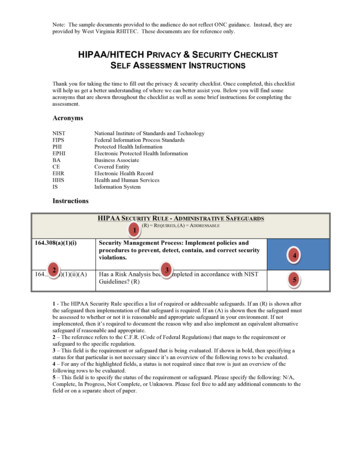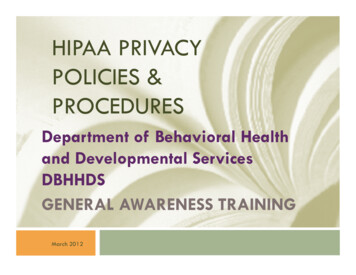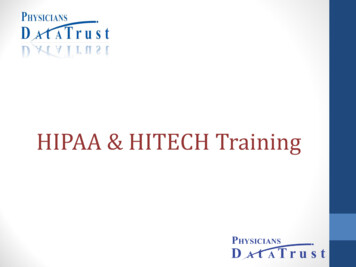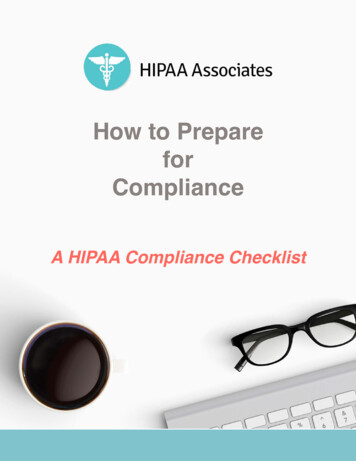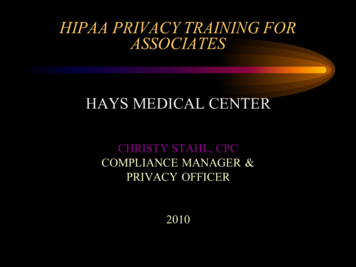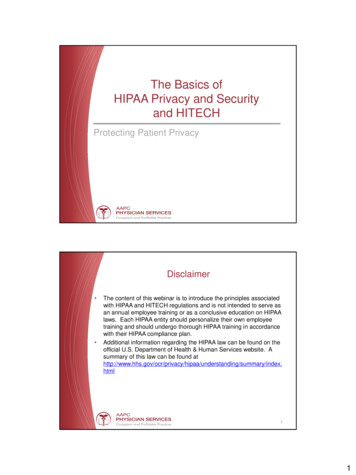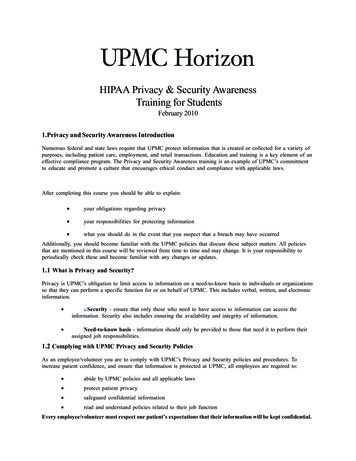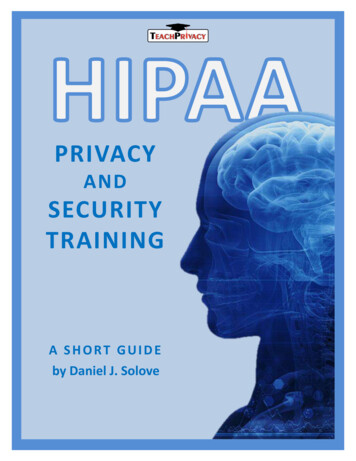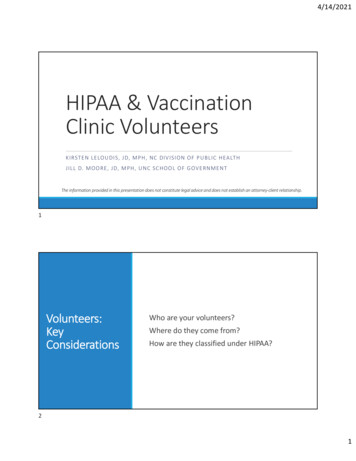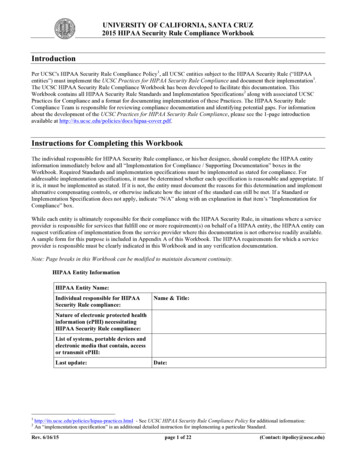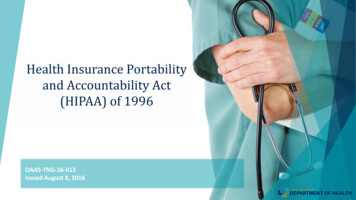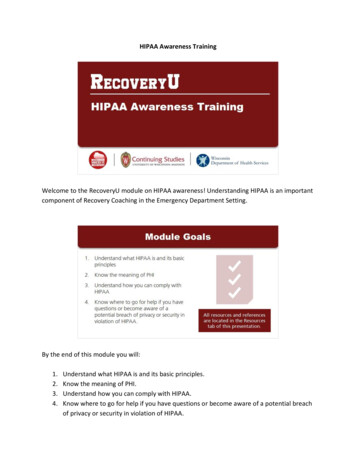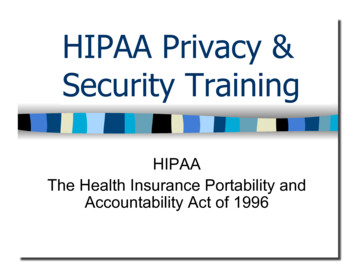
Transcription
HIPAA Privacy &Security TrainingHIPAAThe Health Insurance Portability andAccountability Act of 1996
AMTA confidentialityrequirements AMTA Professional Competencies– 20. Documentation 20.7 Demonstrate knowledge of professionalStandards of Clinical Practice regardingdocumentation. (5.3.3 Place such documentation in theclient's file and maintain its confidentiality unless properauthorization for release is obtained.)– 22. Professional Role/Ethics 22.12 Apply laws and regulations regarding thehuman rights of the clients.
AMTA confidentialityrequirements AMTA Code of Ethics3.0 Relationships with Clients/Students/Research Subjects– 3.12 Confidentiality 3.12.1 The MT protects the confidentiality ofinformation obtained in the course of practice,supervision, teaching, and/or research.
AMTA confidentialityrequirements AMTA Code of Ethics3.12.5 All forms of individually identifiableclient information, including, but not limited toverbal, written, audio, video and digital will beacquired with the informed client or guardianconsent and will be maintained in aconfidential manner by the MT. Also,adequate security will be exercised in thepreservation and ultimate disposition of theserecords.
CBMT Scope of Practice IV. B. Professional Responsibilities7. Maintain client confidentiality within HIPAAprivacy rules.
HIPPA: The Health Insurance Portability andAccountability Act of 1996- Privacy Rule Gives consumers increased control over their PHI.Sets boundaries on the use and disclosure of healthrecords.Establishes safeguards to protect privacy of healthcare information.Holds violators accountable with civil and criminalpenalties.Balances public responsibility when health careinformation must be released to protect the public.
HIPPA: The Health Insurance Portability andAccountability Act of 1996- Privacy Rule The concept of HIPAA’s Privacy and SecurityRegulations is simple:– KEEP INDIVIDUALS’ HEALTH INFORMATIONSECURELY CONFIDENTIAL
Definitions HEALTH INFORMATION.--The term 'health information' means anyinformation, whether oral or recorded in any form or medium, that--”(A) is created or received by a health care provider, health plan, publichealth authority, employer, life insurer, school or university, or healthcare clearinghouse; and”(B) relates to the past, present, or future physical or mental health orcondition of an individual, the provision of health care to an individual,or the past, present, or future payment for the provision of health careto an individual.
Definitions "(6) INDIVIDUALLY IDENTIFIABLE HEALTH INFORMATION.--Theterm 'individually identifiable health information' means any information,including demographic information collected from an individual, that--”– (i) identifies the individual; or”– (ii) with respect to which there is a reasonable basis to believe thatthe information can be used to identify the individual.
What is Protected HealthInformation?Identifiable information refers to information that thatcould be used to identify the patient:– Individual’s name, address, phone/fax numbers,email address– Employer’s name, certificate/license number,voice or fingerprint data– Relative’s names, photos, date of birth – Social Security number, medical record number,membership or account numbers
Definitions "(2) SAFEGUARDS.--Each person who maintainsor transmits health information shall maintainreasonable and appropriate administrative, technical,and physical safeguards--”– (A) to ensure the integrity and confidentiality of the information;– "(B) to protect against any reasonably anticipated--” (i) threats or hazards to the security or integrity of theinformation; and” (ii) unauthorized uses or disclosures of the information
Why is HIPAA important forstudents? The HIPAA rules for privacy and securitywill apply to you when you are assignedas an observer or student in the MTC andaffiliated organizations engaged inproviding health care services, such asschools, hospitals, group homes, nursinghomes and mental health centers.
HIPAA Security Rule
HIPAA Security Rule Effective April 21, 2005Safeguards electronic PHICovers:– Information stored on: Hard drives Disks (CD-RW’s, DVD’s)– Information transmitted through e-mail,Internet, or other means
HIPAA Security Rule Faxes and voice transmissions– Generally, detailed PHI is NOT to be releasedover the telephone even if disclosure is permittedor authorized.– PHI should NOT be faxed, even if disclosure isauthorized or permitted– All faxed PHI shall include a fax coversheetexplaining that the information being faxed isconfidential and should be destroyed if notreceived by the intended recipient.
What is Information Security? The protections in place to ensure PHI is keptconfidential, is not improperly altered or destroyed,and is available for those who are authorized toaccess it.The Music Therapy program and MTC InformationSecurity includes the following:– Hardcopies of documentation– Computer hardware– Software– Information security/practice policies
Documentation Hardcopies Should never have client’s names on them, afirst initial only is recommended.Should not be left where they can be found orread by anyone other than you or yoursupervisor. This includes in your parked andlocked car.Are to be kept in a locked cabinet at the MTCShould be shredded when yourcorresponding course at EMU is completed.
Passwords Are essential in protecting information.Should never be given to anyone includingsupervisors, friends, and fellow students.Should not be stored in a desk, or written ona sticky note and put on a computer.
How to choose a passwordSTRONG passwords: Contain both upper and lower casecharacters (e.g., a-z, A-Z) Have digits and punctuation characters aswell as letters (e.g., 0-9, !@# % &*() - \‘{}[]:";’ ?,./) Are at least eight (8) alphanumeric characterslong Are not based on personal information,names of family, names of pets, etc.
Physical Security Staff, contractors, etc. are given access to the MTC roomson an as needed basis.The MTC computer should be logged off when not in useComputers should not be placed where anyone other thanauthorized users can see what is on the screen. Thismeans when you are using your computer in a publicplace, or using a public computer and doingdocumentation.When using a public computer, do not put a copy fromyour flashdrive onto the public computerClose the browser when done if submitting materialelectronically from a public computer
Electronic Media Disks and other media should be sent to theIT department for destruction.Do not throw away old media. Data can stillbe recovered even if files were deleted.The use of encrypted and password protectedUSB drives to store PHI should be used.Encrypt your USB drive BEFORE savinginformation on it or the info will be lost.
E-mail Use &Transmission of Data Any identifying consumer information is notallowed in e-mail. This includes consumerinitials, consumer ID’s, date of birth, address,etc.Data should not be sent via e-mail withoutbeing encrypted (ZixMail, digital certs, etc).
Offsite Security When working at home, printing of anydemographic or clinical documents containingconsumer information is strictly prohibited.Laptops/Tablets should not be left unattendedand should be password protected.PDA’s/Smart Phones must be passwordprotected.
Level One – Carelessness The unintentional disclosure of PHI.Examples:– Leaving PHI in a public area at work, vehicle,home office, etc.– Inadvertent disclosure of identifying consumerinformation via email, public computer screen, etc.– Inadvertent verbal disclosure of identifyingconsumer informationSanction – At a minimum, corrective action plan andtraining.
Level Two – Improper AccessWithout Disclosure Unauthorized use or misuse of PHI.Violation of “Minimum Necessary” provisions:– Maintaining pictures or other identifying consumerinformation on a computer hard drive (consent issue)– Must be on password protected flashdrive or CD-ROMSanction – A potential minimum of a written reprimand,and could be up to suspension
Level Three – ImproperDisclosure The willful or intentional disclosure of PHI;deliberately obtaining PHI for malicious reasons.Examples include:– Compiling mailing lists for personal use or to sell– Obtaining PHI to get information for maliciousreasons– Disclosing PHI without an appropriate consentSanction – Violations on this level could potentiallyresult in permanent dismissal
Violations and Noncompliance What is a violation?– Inappropriately accessing or releasing information,whether intentional or unintentional.Federal Penalties for noncompliance– Misuse of PHI include fines up to 50,000/imprisonment for a term of up to one year.– Misuse under false pretenses includes fines up to 100,000/imprisonment for a term of up to fiveyears.– Misuse with intent to sell, transfer, or use PHI forcommercial advantage includes fines up to 250,000/imprisonment for a term up to 10 years.
So, what does this mean to you? It is your responsibility to:– Protect our clients’ PHI.– Respect the rights of our clients.– Protect the program from risk of PHI use ordisclosure violation.– Report violations and/or security breachesimmediately.
AMTA confidentiality requirements AMTA Code of Ethics 3.0 Relationships with Clients/Students/ Research Subjects - 3.12 Confidentiality 3.12.1 The MT protects the confidentiality of information obtained in the course of practice,
